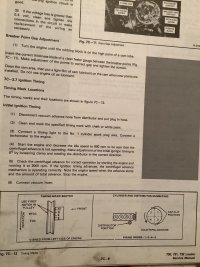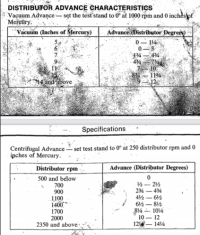Ford Fanatic
Member
- Joined
- Jan 16, 2024
- Messages
- 10
Hey guys, I'm having a problem with my ford 1.6L 2274E engine. It has 780 hours on it, (yes, its a correct reading) and it wont rev up past 1200 Rpm's. I have done the following:
1. Boiled carburetor parts and reassembled with rebuild kit-new jets, diaphragms, adj screws, springs, etcetera.
2. Replaced original breaker points/condenser distributor with pertronix distributor because who wants to deal with condensers and points that cost a fortune, and are hard to find/get?
3. Confirmed good blue spark that jumps 1/2" to engine block
4. Found intake leak between cylinders 2-3-coolant passage, causing cylinders 2-3 to burn lean (at least they were really white-potentially sucking in antifreeze) while 1 and 4 burn rich - repaired leak and now all cylinder plugs have a dark tan color to them.
5. Cold compression check-cylinders 1 and 2 have 120psi, cylinder 3 has 115 psi, and cylinder 4 has 125psi- all within 4 rotations of crankshaft
7. Took the timing cover off and verified cam timing is correct and tensioner is there (i.e. not broken), and chain is tight.
8. Adjusted valve lash to the ford power products manual for this engine and the 1.1L engine, which is .008" for intake valves and .022" for the exhaust valves. Those settings seems somewhat weird compared to other engines that I've dealt with, but eh, that's what it calls for and I ain't no engineer haha
9. I don't have the precision tools necessary to verify that the valves are opening 100% fully-which would point to a worn camshaft, but that seems very unlikely for only having 780 hours on it, plus, just watching them open and close when I rotate the crank they seem to compress their springs plenty far
10. Removed the exhaust manifold to make sure no blockages are in the pipes- i.e. mouse nests, or what have you-it sat in my garage for a few years so you never know. I've seen that in snowmobile air boxes so it was worth a look see. nothing found, all clear
With all that mentioned, it still won't rev up past 1200 RPM. Machine moves very slowly at that engine rpm, and all hydraulics work, but also very slow lift, tilt and auxiliary functions. After all that troubleshooting and repairing/replacing parts I'm at a loss. I know I'm missing something simple. any ideas from anyone who wants to share? Thanks in advance.
1. Boiled carburetor parts and reassembled with rebuild kit-new jets, diaphragms, adj screws, springs, etcetera.
2. Replaced original breaker points/condenser distributor with pertronix distributor because who wants to deal with condensers and points that cost a fortune, and are hard to find/get?
3. Confirmed good blue spark that jumps 1/2" to engine block
4. Found intake leak between cylinders 2-3-coolant passage, causing cylinders 2-3 to burn lean (at least they were really white-potentially sucking in antifreeze) while 1 and 4 burn rich - repaired leak and now all cylinder plugs have a dark tan color to them.
5. Cold compression check-cylinders 1 and 2 have 120psi, cylinder 3 has 115 psi, and cylinder 4 has 125psi- all within 4 rotations of crankshaft
7. Took the timing cover off and verified cam timing is correct and tensioner is there (i.e. not broken), and chain is tight.
8. Adjusted valve lash to the ford power products manual for this engine and the 1.1L engine, which is .008" for intake valves and .022" for the exhaust valves. Those settings seems somewhat weird compared to other engines that I've dealt with, but eh, that's what it calls for and I ain't no engineer haha
9. I don't have the precision tools necessary to verify that the valves are opening 100% fully-which would point to a worn camshaft, but that seems very unlikely for only having 780 hours on it, plus, just watching them open and close when I rotate the crank they seem to compress their springs plenty far
10. Removed the exhaust manifold to make sure no blockages are in the pipes- i.e. mouse nests, or what have you-it sat in my garage for a few years so you never know. I've seen that in snowmobile air boxes so it was worth a look see. nothing found, all clear
With all that mentioned, it still won't rev up past 1200 RPM. Machine moves very slowly at that engine rpm, and all hydraulics work, but also very slow lift, tilt and auxiliary functions. After all that troubleshooting and repairing/replacing parts I'm at a loss. I know I'm missing something simple. any ideas from anyone who wants to share? Thanks in advance.



